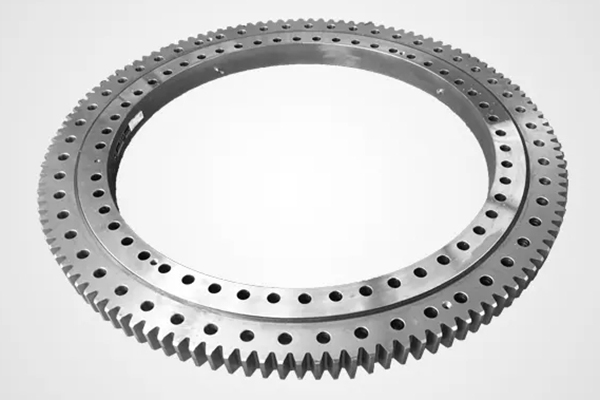
What Is the Function of a Slew Ring?
2025-01-04
A slewing ring, also known as a slewing bearing or turntable bearing, is a critical component used in various heavy-duty applications to enable rotational movement between two structures. It is essential in industries such as construction, manufacturing, shipping, and renewable energy. Understanding the function of a slew ring helps clarify its importance in the performance and longevity of large machinery. This article will explore what a slew ring is, its key functions, and its applications across different sectors.
What Is a Slew Ring?
A slew ring is a large bearing that allows rotational or turning movement between two parts of a machine or structure. It consists of an inner ring and an outer ring, with rolling elements like balls or rollers in between. These elements reduce friction, making it easier for one part of the machine to rotate relative to the other.
Unlike traditional bearings, a slew ring is designed to handle heavy loads, including axial (vertical), radial (horizontal), and tilting moment loads simultaneously. This capability makes it ideal for machines and equipment that require both stability and rotational movement.

Key Functions of a Slew Ring
The primary function of a slew ring is to provide smooth rotational movement while bearing significant loads. Below are its core functions:
1. Enabling Rotational Movement
A slew ring allows large structures or machine parts to rotate efficiently. This is particularly important in applications where precision and smooth movement are required. For example, cranes use slew rings to rotate their booms, allowing them to lift and place heavy objects at different angles.
2. Supporting Heavy Loads
One of the critical functions of a slew ring is to support heavy axial, radial, and tilting loads. These bearings are designed to handle substantial weights without compromising performance. In wind turbines, for instance, the slew ring supports the nacelle and allows it to rotate and face the wind for optimal energy generation.
3. Reducing Friction
Slew rings reduce friction between rotating parts, which is essential for the efficient operation and longevity of the machinery. The rolling elements inside the bearing minimize resistance, making it easier for the machine to rotate smoothly, even under heavy loads.
4. Providing Stability
In addition to facilitating movement, slew rings provide stability to large machines by ensuring that rotational movements are controlled and balanced. This stability is crucial in applications like excavators and cranes, where uncontrolled rotation could result in accidents or damage.
Types of Slew Rings
There are different types of slew rings, each designed for specific applications:
- Single-Row Ball Slewing Bearing:
- Commonly used in light to medium-duty applications.
- Suitable for machines that require precise rotational movement.
- Double-Row Ball Slewing Bearing:
- Designed for heavier loads.
- Commonly used in cranes, excavators, and wind turbines.
- Cross-Roller Slewing Bearing:
- Provides higher accuracy and stability.
- Ideal for applications requiring precise positioning, such as robotics and medical equipment.
- Three-Row Roller Slewing Bearing:
- Designed for extremely heavy loads.
- Used in large industrial machinery and offshore equipment.
Applications of Slew Rings
Slew rings are used in a wide range of industries and applications, including:
1. Construction Equipment
Slew rings are integral to construction equipment such as cranes, excavators, and concrete pumps. They enable these machines to rotate and perform tasks from different angles without moving the base structure.
2. Wind Turbines
In wind turbines, slew rings allow the nacelle (the housing that contains the turbine’s components) to rotate and face the wind direction for maximum efficiency. They also support the blades during rotation, ensuring stability and durability.
3. Medical Equipment
Slew rings are used in medical devices like CT scanners and surgical tables. These bearings allow the equipment to rotate smoothly and accurately, improving patient care and diagnostic precision.
4. Marine and Offshore Equipment
In the maritime sector, slew rings are found in ship cranes, offshore drilling rigs, and radar systems. They enable smooth and reliable rotational movement in challenging environments, such as rough seas and high winds.
5. Robotics
Slew rings play a vital role in robotic arms and automated systems. They provide precise rotational movement and stability, ensuring the robots can perform tasks accurately and efficiently.
Benefits of Using Slew Rings
Using a slew ring in machinery offers several advantages:
- Enhanced Load Capacity: Capable of handling multiple types of loads at once.
- Smooth Rotational Movement: Reduces friction for efficient and smooth movement.
- Increased Stability: Provides balance and stability to rotating equipment.
- Durability: Designed to withstand harsh conditions and heavy use.
- Versatility: Suitable for a wide range of applications across industries.
Maintenance Tips for Slew Rings
Proper maintenance is essential to ensure the longevity and performance of a slew ring:
- Regular Lubrication:
- Use appropriate lubricants to reduce friction and wear.
- Inspect for Wear and Damage:
- Check for cracks, wear, and loose bolts regularly.
- Clean the Bearing:
- Keep the bearing clean and free from debris to prevent damage.
- Check Fasteners:
- Ensure that all bolts and fasteners are tightened correctly to avoid accidents.
Conclusion
A slew ring is a vital component in various machines and equipment, providing rotational movement, load support, and stability. From construction equipment and wind turbines to medical devices and robotics, slew rings play a crucial role in enhancing the performance and functionality of different applications. Understanding their function and importance can help users choose the right type of slew ring for their needs and ensure proper maintenance for long-term use.





